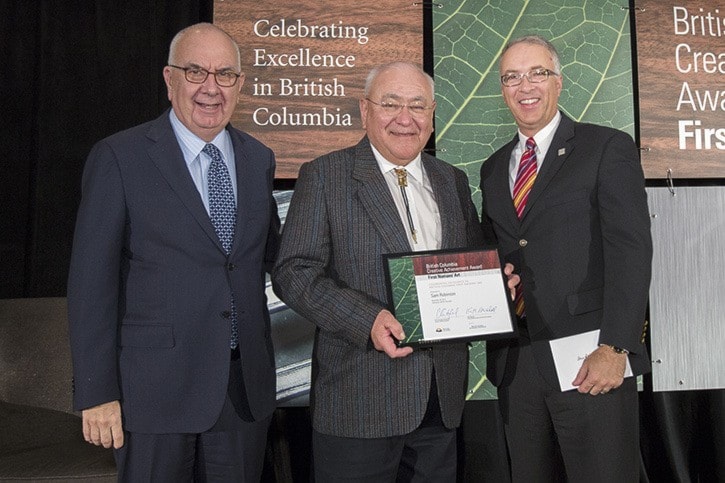Over more than seven decades Sammy Robinson has distinguished himself. Not only has he ascended to the lofty post of hereditary chief of the Haisla Nation, but he has earned many accolades. Just last year (2013), a B.C. Creative Achievement Award was bestowed upon him for his many talents.
In addition to creating exquisite bracelets, masks and carvings, Sammy has a linguistic ability with Haisla - he grew up speaking the language - a knowledge and skill in teaching First Nations dances plus the knowledge and ability to guide fishermen and tell stories of his culture within the natural world of the Douglas Channel.
A proud member of the Beaver Clan, Chief Sammy has over the years shared his creativity and, indirectly, some of the Haisla stories world-wide. Amongst other things he was a dance troupe leader who was able to showcase First Nations drumming and dancing clear across the Pacific in Malaysia. In 1967 he was appointed as a special carving dignitary at the Montreal Expo world’s fair and he was a resident carver on site at the 1970 Olympic Games. Over the years he has accumulated a number of awards. Amongst his earliest were First Nations art awards at Vancouver’s PNE back in 1963. Some of his carvings are proudly displayed in the Place Bonaventure in downtown Montreal and hockey’s ean B liveau and skiing’s Nancy Greene are among the many who have Sammy’s carvings.
He admits that it was often difficult to part with some of his carvings. For it is passion, not money, that drives Sammy. The spirits and creatures hidden within the knots and wood grain swirls call out to him. Sometimes the inspirations are insistent and he just can’t put his tools down. He concedes favouring the beaver in his art but insists it has not restricted him. The beaver is at the bottom of the pole, the eagle at the top, and the raven is commonly in the middle. And of course they tell Haisla stories. In his early years work was usually in wood, especially yellow cedar, and Argilite stone was used from time to time. But in recent years Sammy has predominantly worked in gold and silver.
As a channel guide he saw oh so many clients, although it was often about more than fish as they travelled waterways throughout Haisla territory and beyond. One of Sammy’s fondest memories was guiding a client in landing a 76-pound spring salmon in Fraser Reach near Butedale. He claims that client nearly had a heart-attack in his excitement.
Sammy’s life as a child was not easy. Unlike most of his Haisla brethren, he did not attend residential school - this was at great risk to his parents. He spent most of his youth, in fact 27 years, living and working in Butedale, the cannery village on Princess Royal Island 85 miles south of Kitamaat. At Butedale, he was able to fish much of his time. He still fondly remembers the visits of the various ships on their way up the Inside Passage to Alaska. Often they stopped long enough to enable Sammy and his friends to make on-board purchases of chocolate bars and the like. He was even able to sell some of his early carvings. His nephew, Lyle Wilson, also a carver, was actually born at Butedale during those years. Sammy’s grandmother was a great support in encouraging his art and inspiring him to do his best: she always said, “You’re going to be chief one day.”
Sammy still remembers his early struggles and can well remember the times when First Nations people could not vote or even take out a mortgage, although he does point out that later he was one of the first to get a loan for a new boat purchase.
He has had a succession of boats over the years, all adding to the memories. His current aluminum boat is Four Rose, named in honour of his wife, best friend and long-time partner Rose.
Sammy can clearly remember the days when Maggie Cordella lived in a cabin near Maggie Point, the current site of the gazebo on the TzeMotsa trail.
Even in his retirement years Sammy often puts in an eight-hour day, a significant reduction from fourteen. But he admits that he can’t do the dance moves he could years ago.
He knows that someday a successor will fill his shoes, appointed in an age-old ancestral tradition secretly known to Haisla elders. And while he can foresee a prosperous future for his people, he does wonder how many will carry on the Haisla language. He does hope and expect that someday more Haisla materials will be repatriated to Kitamaat, perhaps even the Raley collection could be back home.
Walter Thorne writes the Northern Sentinel's It's Our Heritage column
